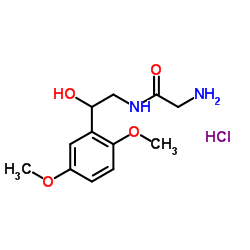UNII:59JV96YTXV

UNII:59JV96YTXV structure
|
Common Name | UNII:59JV96YTXV | ||
|---|---|---|---|---|
| CAS Number | 3092-17-9 | Molecular Weight | 290.743 | |
| Density | N/A | Boiling Point | 529.9ºC at 760 mmHg | |
| Molecular Formula | C12H19ClN2O4 | Melting Point | 192-193ºC | |
| MSDS | Chinese USA | Flash Point | 274.3ºC | |
| Symbol |

GHS06 |
Signal Word | Danger | |
|
The role of eNOS phosphorylation in causing drug-induced vascular injury.
Toxicol. Pathol. 42(4) , 709-724, (2014) Previously we found that regulation of eNOS is an important part of the pathogenic process of Drug-induced vascular injury (DIVI) for PDE4i. The aims of the current study were to examine the phosphorylation of eNOS in mesentery versus aorta at known regulator... |
|
|
MicroRNA changes in rat mesentery and serum associated with drug-induced vascular injury.
Toxicol. Appl. Pharmacol. 262(3) , 310-20, (2012) Regulatory miRNAs play a role in vascular biology and are involved in biochemical and molecular pathways dysregulated during vascular injury. Collection and integration of functional miRNA data into these pathways can provide insight into pathogenesis at the ... |
|
|
Ion selective phosphotungestate and beta-cyclodextrin based membrane electrodes for stability-indicating determination of midodrine hydrochloride.
Acta Chim. Slov. 60(2) , 256-62, (2013) This paper reports the construction and evaluation of two ion selective electrodes for the determination midodrine hydrochloride (MD) by direct potentiometry in pure drug substance and in tablet formulations. Precipitation based technique was used for fabrica... |
|
|
Efficacy of atomoxetine versus midodrine for the treatment of orthostatic hypotension in autonomic failure.
Hypertension 64(6) , 1235-40, (2014) The clinical presentation of autonomic failure is orthostatic hypotension. Severely affected patients require pharmacological treatment to prevent presyncopal symptoms or frank syncope. We previously reported in a proof of concept study that pediatric doses o... |
|
|
A prospective, 1-year follow-up study of postural tachycardia syndrome.
Mayo Clin. Proc. 87(8) , 746-52, (2012) To prospectively evaluate patients who met standard criteria for postural tachycardia syndrome (POTS), at baseline and 1-year follow-up, using standard clinical and laboratory methods to assess autonomic function.Fifty-eight patients met the study criteria (o... |
|
|
Midodrine and clonidine in patients with cirrhosis and refractory or recurrent ascites: a randomized pilot study.
Am. J. Gastroenterol. 108(4) , 560-7, (2013) Splanchnic arterial vasodilatation and subsequent activation of anti-natriuretic and vasoconstrictive mechanisms have an important role in cirrhotic ascites. The aim of this study was to evaluate the effects of midodrine, clonidine, and their combination on s... |
|
|
Orthostatic effects of midodrine versus L-NAME on cerebral blood flow and the renin-angiotensin-aldosterone system in tetraplegia.
Arch. Phys. Med. Rehabil. 92(11) , 1789-95, (2011) To compare responses to head-up tilt (HUT) in individuals with chronic tetraplegia after midodrine hydrochloride (10 mg) versus nitro-L-arginine methyl ester (L-NAME, 1 mg/kg) administration.Prospective comparative drug trial.Veterans Affairs medical center.P... |
|
|
Flow-mediated vasodilation as a predictor of therapeutic response to midodrine hydrochloride in children with postural orthostatic tachycardia syndrome.
Am. J. Cardiol. 112(6) , 816-20, (2013) This study was designed to explore the value of flow-mediated vasodilation (FMD) as a predictor of therapeutic response to midodrine hydrochloride (MD) in children with postural orthostatic tachycardia syndrome (POTS). One hundred and eight children diagnosed... |
|
|
Refractory hypotension after bilateral nephrectomies in a Denys-Drash patient with phenylketonuria.
Pediatr. Nephrol. 28(2) , 345-8, (2013) Denys-Drash (DDS) syndrome is a rare genetic syndrome resulting from a mutation in the Wilms' tumor suppressor gene 1 (WT1), which presents with early onset nephrotic syndrome progressing rapidly to end-stage kidney disease (ESKD), pseudohermaphroditism, and ... |
|
|
The combination of octreotide and midodrine is not superior to albumin in preventing recurrence of ascites after large-volume paracentesis.
Clin. Gastroenterol. Hepatol. 10(10) , 1169-75, (2012) Large-volume paracentesis (LVP) is the treatment of choice for patients with cirrhosis and refractory ascites. However, LVP can lead to postparacentesis circulatory dysfunction (PCD), which is associated with faster ascites recurrence and renal failure. PCD r... |